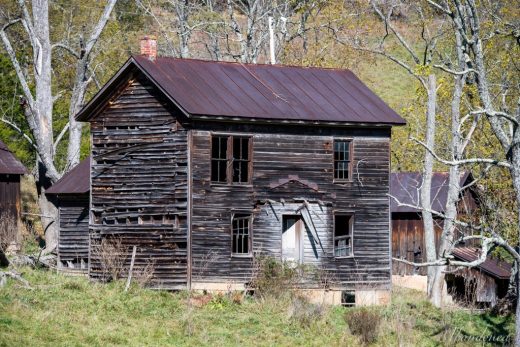There was no better…
There was no better way than spending autumn driving the backroads and camping in the Potomac Highlands region of West Virginia, photographing forlorn houses, historic sites, covered bridges, and vast landscapes against a backdrop of golden hues.
Coming over South Fork Mountain, I stumbled upon a long-abandoned wood weatherboard-sided residence in the middle of a cow pasture. With thanks to a friendly neighbor and owner, I was able to drive onto the farm for a closer view of this still-sturdy structure.
Situated on about 75 acres of rolling hills in the shadow of South Fork Mountain, the Simmons Farm was a historically self-sufficient farmstead consisting of several log and frame buildings constructed by hand and derived from local materials. The two-story, three-bay frame house, with a 1½-story rear wing, was constructed atop a concrete foundation circa 1908. The first floor front door opened onto a front porch long removed. Other features include original 2/2 and 3/3 windows and a standing seam tin roof. Inside, it was finished with mostly bare wood inside, and its only embellishment hand stenciling on the ceiling in the living room was completed by its primary occupant who was a local painter. Other structures on the traditional mountain farm complex include a woodworking shop, a combination corn crib and barn, the ruins of a spring house, and an outbuilding with chicken crates. A family cemetery rests on the hilltop.
Over the hill is the William C. Miller Home that was built on the site of Fort Seybert in the 1890s. While the house may not be entirely notable outside of its Folk Victorian architecture, the fort itself was because of a surprise attack by Shawnee and Delaware warriors on the foggy morning of April 28, 1758. Thirty white settlers, left practically defenseless as several men had left for business across the Shenandoah Mountains, were massacred.
Fort Seybert was one of 23 frontier forts that had been built in Virginia along the western frontier.
Around 1800, the land was farmed by the Miller family, who constructed the two-story house. An addition was made to the front around the turn of the century, and vergeboard with delicate fan ornamentation with pendants was later added to the gable ends circa 1915. Coupled with its tall 2/2 windows, wide porch, and standing seam tin roof, the residence commanded presence above the adjoining roadway.
Further north, the first surveys of the “upper tract” of the South Branch valley were performed around 1750. A sudden wave of European immigration into the area several years later led to diverse groups settling into its broad valleys and along its forested ridgelines. Samuel Kline, who hailed from Germany, came to the area prior to 1861 and served as postmaster for an unincorporated community along Mill Run at Greenawalt Gap. Ultimately, the community took the name of its postmaster circa 1875, first being called Klines Cross Roads and then more simply Kline.
One of the more interesting structures at Kline is the old hotel and general store, which I had stumbled upon while exploring the region about ten years prior. The clapboard-sided two-story structure features a broad front-facing porch, numerous 2/2 windows, dormers, and a traditional standing seam tin roof.
[envira-gallery-dynamic id=”tags-kline-hotel”]
Equally as interesting is the unique architecture that I’ve noted only in this region. This particular example was constructed in 1904 and is an example of Queen Anne and vernacular architecture. The house features original wood clapboard siding, decorative trim, replacement windows and doors, and a broad parapet. I assumed that the parapet was not original, but there are three nearby structures (example) that feature the distinctive style, all dating from the same period.
The house was in much better shape ten years ago. The owner died recently, and the house and yard have become overrun with feral cats.
[envira-gallery-dynamic id=”tags-kline-house-1″]
Located at the foot of Greenawalt Gap in Mill Run are the ruins of an old mill. I presume the flood of 1985 did considerable damage to the building, which eventually collapsed.
[envira-gallery-dynamic id=”tags-kline-mill-ruins”]
It is adjacent to a quaint circa 1890 house with original wood trim, 2/2 windows, a standing seam porch, and a rotting front porch seemingly being supported with cut trees.
[envira-gallery-dynamic id=”tags-kline-house-2″]
Also located in Kline is the former County Route 1 bridge over Mill Run. The five-panel pinned Pratt pony truss was abandoned in 1988 when it was replaced with an ugly modern concrete structure. The bridge was relocated to an adjoining farm and never repurposed.
[envira-gallery-dynamic id=”tags-kline-bridge”]
A second installment to this post will be forthcoming.







3 Comments
Add Yours →[…] More Info abandonedonline.net […]
Can u tell us more about the hotel u pictured in Kline Wv…No one living today has ever heard of it being a hotel
My recollection was based on a conversation I had with the lady who lived caddy-corner some 10 years ago (she has since passed). I would love to know more about it, though.